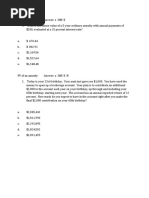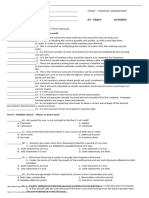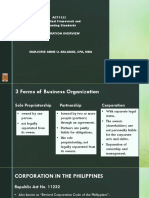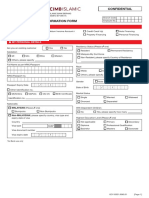Pas 24
Uploaded by
angelo vasquezPas 24
Uploaded by
angelo vasquezProblem 4-1 Multiple Choice (PAS 24)
1. Related parties include all the following, except
a. Parent, subsidiary and fellow subsidiaries
b. Associates
c. Key management personnel and close family members of such key management
personnel
d. Two venturers simply because they share joint control over a joint venture.
2. A related party transaction is a transfer
a. Between related parties when a price is charged.
b. Between related parties, regardless of whether a price is charged.
c. Between unrelated parties when a price is charged.
d. Between unrelated parties, regardless of whether a price is charged.
3. Unrelated parties include which of the following?
a. Providers of finance in the course of their normal dealings with an entity by virtue only of
those dealings.
b. Government agencies
c. Single customer with whom an entity transacts a significant volume of business merely
by virtue of the resulting economic dependence.
d. All of these are unrelated parties.
4. Close family members of an individual include all, except
a. The individual’s spouse and children
b. Children of the individual’s spouse
c. Dependents of the individual or individual’s spouse
d. Brothers and sisters of the individual
5. The minimum disclosure about related party transactions include all of the following,
except
a. The amount of transaction
b. Amount of outstanding balance
c. Allowance for doubtful accounts related to the outstanding balance
d. Nature of the relationship
Problem 4-2 Multiple Choice (IFRS)
1. Which is not included in key management personnel compensation?
a. Short-term benefit
b. Share-based payment
c. Termination benefit
d. Reimbursement of out-of-pocket expenses
2. Which of the following is not a mandated disclosure about related party transactions?
a. Relationship between parent and subsidiaries
b. Names of all the associates that an entity has dealt with during the year
c. Name of the entity’s parent and if different, the ultimate controlling party
d. If neither the entity’s parent nor the ultimate controlling entity produces financial
statements available for public use, then the name of the next most senior parent that does
so
3. Which of the following is not a required minimum disclosure about related party
transaction?
a. The amount of related party transaction
b. The amount of the outstanding balance
c. The amount of similar transaction with unrelated parties to establish that comparable
related party transaction has been entered at arm’s length
d. Doubtful debt related to the outstanding balance
4. Related party transaction include all, except
a. A venturer sold goods to the joint venture
b. Sold a car to the uncle of the entity’s finance director
c. Sold goods to another entity owned by the daughter of the managing director
d. All of these are related party transactions
5. All of the following are related party transactions, except
a. Transferred goods from inventory to a subsidiary
b. Sold an entity car to the wife of the managing director
c. Sold an asset to an associate
d. Took out a huge bank loan
6. An entity that entered into a related party transaction would be required to disclose all of
the following information, except
a. Nature of the relationship between the parties
b. Nature of any future transactions planned between the parties and the terms involved
c. Peso amount of the transaction
d. Amount due from or to related parties at the end of reporting period
7. Which is not a required related party disclosure?
a. The son of the chief executive officer of the entity
b. The parent of the entity
c. An entity that has a common director with the entity
d. Joint venture in which the entity is a venturer
8. All of the following are related parties, except
a. Joint venture in which the entity is a venturer
b. A postemployment benefit plan for the employees
c. An executive director of the entity
d. The partner of a key manager is a major supplier of the entity
9. Which of the following is not a related party of an entity?
a. A shareholder of the entity owning twenty percent
b. An entity providing banking facilities to the entity
c. An associate of the entity
d. Key management personnel of the entity
10. Which of the following should be included in key management personnel compensation?
a. Social security contributions
b. Postemployment benefits
c. Social security contributions and postemployment benefits
d. Social security contributions, postemployment benefits and dividends to shareholders
Problem 5-1 (IFRS)
Caroline Company provided the following information on December 31, 2019:
1/13/2020 P 3,000,000 of accounts receivable was written off due to the bankruptcy of a
major customer.
2/14/2020 A shipping vessel of Caroline with carrying amount of P 5,000,000 was
completely lost at sea because of a hurricane.
3/11/2020 A court case involving Caroline as the defendant was settled and the entity was
obligated to pay the plaintiff P 1,500,000. Caroline previously recognized a P 1,000,000 liability
for the suit because management deemed it probable that the entity would lose the case.
3/25/2020 One of Caroline’s factories with a carrying amount of P 15,000,000 was
completely razed by forest fires that erupted in its vicinity.
The management of the entity completed the draft of the financial statements for 2019 on
February 10, 2020.
On March 20, 2020 the board of directors authorized the financial statements for issue. The
entity announced the profit and other selected information on March 22, 2020.
The financial statements were made available to shareholders on April 2, 2020 at the annual
shareholders meeting where the financial statements were approved.
The financial statements were filed with the regulatory agency the very next day.
Required:
1. Prepare adjusting entries on December 31, 2019 to reflect the adjusting events after
reporting period.
2. Prepare the necessary disclosures to reflect the non-adjusting events after reporting
period.
Problem 5-2 (IFRS)
Elaine Company prepared draft financial statements that showed the profit before tax for the year
ended December 31, 2019 at P 9,000,000. The board of directors authorized the financial
statements for issue on March 20, 2019.
A fire occurred at one of Elaine’s sites on January 15, 2020 with resulting damage amounting to
P 7,000,000, only P 4,000,000 of which is covered by insurance. The repairs will take place and
be paid for in April 2020.
The P 4,000,000 claim from the insurance entity will however be received on February 14, 2020.
What amount should be reported as profit before tax in the financial statements?
a. P 2,000,000
b. P 9,000,000
c. P 4,000,000
d. P 6,000,000
Problem 5-3 (IFRS)
During 2019, Marian Company was sued by a competitor for P 5,000,000 for infringement of a
patent.
Based on the advice of the legal counsel, the entity accrued the sum of P 3,000,000 as a
provision in the financial statements for the year ended December 31, 2019.
Subsequently, on March 15, 2020, the Supreme Court decided in favor of the party alleging
infringement of the patent and ordered the defendant to pay the aggrieved party a sum of P
3,500,000.
The financial statements were prepared by the entity’s management on February 15, 2020 and
approved by the board of directors on March 31, 2020.
What amount should be recognized as accrued liability on December 31, 2019?
a. P 5,000,000
b. P 3,500,000
c. P 3,000,000
d. P 1,500,000
Problem 5-4 (IFRS)
Carla Company carried a provisions of P 2,000,000 in the draft financial statements for the year
ended December 31, 2019 in relation to an unresolved court case.
On January 31, 2020, where the financial statements for the year ended December 31, 2019 had
not yet been authorized for issue, the case was settled and the court decided the fixed total
damages to be paid by the entity at P 3,000,000.
What amount should be adjusted on December 31, 2019 in relation to this event?
a. P 3,000,000
b. P 2,000,000
c. P 1,000,000
d. P0
Problem 5-5 (IFRS)
Pink Company is completing the preparation of the draft financial statements for the year ended
December 31, 2019.
The financial statements are authorized for issue on March 31, 2020.
On January 31, 2020, a dividend of P 2,000,000 was declared and a contractual profit share
payment of P 200,000 was made, both based on the profit for the year ended December 31, 2019.
On February 15, 2020, a customer went into liquidations having owed the entity P 900,000 for
the past 5 months. No allowance had been made against this debt in the draft financial
statements.
On March 1, 2020, a manufacturing plant was destroyed by fire resulting in a financial loss of P
2,500,000.
What total amount should be recognized in profit or loss for the year ended December 31, 2019
to reflect adjusting events after the end of reporting period?
a. P 2,000,000
b. P 3,600,000
c. P 2,500,000
d. P 1,100,000
Problem 5-6 Multiple Choice (IFRS)
1. At the end of current reporting period an entity carried a receivable from a major
customer who declared bankruptcy after the end of reporting period and before the
issuance of financial statements. What should be reported at the current year-end?
a. Disclosure the fact that the customer has declared bankruptcy.
b. Make a provision for the event after reporting period in the financial statements.
c. Ignore the event and wait for the outcome of the bankruptcy.
d. Reverse the sale pertaining to the receivable in the comparative statement for the prior
period.
2. An entity decided to build and operate an amusement park next year. The entity applied
for a letter of guarantee which was issued before the issuance of the financial statements
of the current year. What is the adjustment required at the current year-end?
a. Book a long-term payable for the amount of guarantee.
b. Disclose the guarantee as a contingent liability.
c. Increase the contingency reserve.
d. Do nothing.
3. An entity built a new factory building during the current year. Subsequent to the current
year-end and before issuance of financial statements, the building was destroyed by fire
and the claim against the insurance entity provided futile because the cause of the fire
was negligence on the part of the caretaker of the building. What should be reported at
the current year-end?
a. Write off the carrying amount of the building.
b. Make a provision for one-half of the carrying amount of the building.
c. Make a provision for three-fourths of the carrying amount of the building.
d. Disclose the non-adjusting event in the notes to financial statements.
4. An entity deals extensively with foreign currency transactions. Subsequent to the end of
reporting period and before the date of authorization of the issuance of the financial
statements, there were abnormal fluctuations in foreign currency rate. What should be
reported at the current year-end?
a. Adjust the foreign exchange year-end balances to reflect the abnormal adverse
fluctuations.
b. Adjust the foreign exchange year-end balances to reflect all abnormal fluctuations and
not just adverse movements.
c. Disclose the post-reporting period event.
d. Ignore the post-reporting period event.
5. Which statements is true in relation to events after reporting period?
a. Notes to the financial statements should give details of material adjusting events included
in those financial statements.
b. Notes to the financial statements should give details of material non-adjusting events
which could influence the economic decisions of users.
c. A decline in the market value of investments would normally be classified as an adjusting
event.
d. The settlement of a long-running court case would normally be classified as a non-
adjusting event.
Problem 5-7 Multiple Choice (IAA)
1. Which event after the reporting period would require adjustment?
a. Loss of plant as a result of fire.
b. Change in the market price of investment.
c. Loss on inventory resulting from flood loss.
d. Loss on a lawsuit the outcome of which was deemed uncertain at year-end.
2. Events that occur after the current year-end but before the financial statements are issued
and affect the reliability of accounts receivable should be
a. Discussed only in the management annual report.
b. Disclosed only in the notes to financial statements.
c. Used to record an adjustment to bad debt expense.
d. An adjustment directly to retained earnings.
3. Non-adjusting events include all, except
a. A major business combination after reporting period
b. Announcing a plan to discontinue an operation
c. Expropriation of a major asset after reporting period
d. Destruction of a major production plant by a fire before the end of the reporting period
4. Non-adjusting events include all, except
a. The entity announced the discontinuation of an operation.
b. The entity entered into an agreement to purchase the leased building.
c. Destruction of a building by earthquake after the end of reporting period.
d. A mistake in the calculation of allowance for uncollectible accounts receivable.
5. Which event after the end of reporting period would generally require disclosure?
a. Retirement of key management personnel
b. Settlement of litigation when the event that gave rise to the litigation occurred in a prior
period.
c. Strike of employees
d. Issue of a large amount of ordinary shares
You might also like
- Project Management A Managerial Approach 8th Edition Meredith Test Bank - Instantly Accessible In Full PDF VersionNo ratings yetProject Management A Managerial Approach 8th Edition Meredith Test Bank - Instantly Accessible In Full PDF Version51 pages
- Mamaearth+Case+Study+Submission+PPT+ (2) + (2) Final100% (3)Mamaearth+Case+Study+Submission+PPT+ (2) + (2) Final17 pages
- Jeffrey G. Williamson - Trade and Poverty - When The Third World Fell Behind - The MIT Press (2011) PDF100% (1)Jeffrey G. Williamson - Trade and Poverty - When The Third World Fell Behind - The MIT Press (2011) PDF315 pages
- Customer Perception Towards Online Shopping at Flipkart PDF100% (2)Customer Perception Towards Online Shopping at Flipkart PDF11 pages
- Ventura, Mary Mickaella R - p.44 - Statement of Financial PositionNo ratings yetVentura, Mary Mickaella R - p.44 - Statement of Financial Position6 pages
- Assignment 2 (Malaysian Logistics Industry Development Report) - (Roshanita Binti Ramli-2018298546-Kba2444a) .Edited100% (1)Assignment 2 (Malaysian Logistics Industry Development Report) - (Roshanita Binti Ramli-2018298546-Kba2444a) .Edited12 pages
- Preliminary Examination Reviewer: Intermediate Accounting 2 (Ca51010)No ratings yetPreliminary Examination Reviewer: Intermediate Accounting 2 (Ca51010)11 pages
- ACC_109_P3_EXAM_SETB_TEACHERS_COPY.docxNo ratings yetACC_109_P3_EXAM_SETB_TEACHERS_COPY.docx19 pages
- IA3-Mid-term-examination-1st-Sem-SY-24-25No ratings yetIA3-Mid-term-examination-1st-Sem-SY-24-259 pages
- Cpa Review School of The Philippines ManilaNo ratings yetCpa Review School of The Philippines Manila6 pages
- Accounting Changes Quizzer 2 - With AnswerNo ratings yetAccounting Changes Quizzer 2 - With Answer5 pages
- Prelims 1st Quiz Cost Accounting and Control 1 PDF100% (1)Prelims 1st Quiz Cost Accounting and Control 1 PDF30 pages
- Asset Standard Initial Measurement Subsequent Measurement Included in Profit or Loss Financial POSITION PresentationNo ratings yetAsset Standard Initial Measurement Subsequent Measurement Included in Profit or Loss Financial POSITION Presentation3 pages
- Practice Drills - Accounting For CorporationNo ratings yetPractice Drills - Accounting For Corporation7 pages
- The Assembly Department Uses A Process Cost Accounting System and A Weighted-Average CostNo ratings yetThe Assembly Department Uses A Process Cost Accounting System and A Weighted-Average Cost5 pages
- Chapter 1-Introduction To Cost Accounting: True/FalseNo ratings yetChapter 1-Introduction To Cost Accounting: True/False1 page
- DBMSfor BAwith Analytics Workbookv 2023No ratings yetDBMSfor BAwith Analytics Workbookv 202330 pages
- Bank Reconciliation Problems For DiscussionNo ratings yetBank Reconciliation Problems For Discussion4 pages
- Ventura, Mary Mickaella R - Revenue From Contracts - p.205 - Group3No ratings yetVentura, Mary Mickaella R - Revenue From Contracts - p.205 - Group34 pages
- Chapter 20 - Operating Segments: QUESTION 20-15 Multiple Choice (PFRS 8)No ratings yetChapter 20 - Operating Segments: QUESTION 20-15 Multiple Choice (PFRS 8)7 pages
- ACTG 431 QUIZ Week 2 Theory of Accounts Part 2 - FINANCIAL ASSET AT AMORTIZED COST QUIZNo ratings yetACTG 431 QUIZ Week 2 Theory of Accounts Part 2 - FINANCIAL ASSET AT AMORTIZED COST QUIZ4 pages
- Intangible Asset (Pas 38) : Introduction, Scope and DefinitionsNo ratings yetIntangible Asset (Pas 38) : Introduction, Scope and Definitions20 pages
- CFAS Prelim Assessment - Conceptual FrameworkNo ratings yetCFAS Prelim Assessment - Conceptual Framework5 pages
- Partnership Co Owenership Joint Venture and Fringe Benefits PDFNo ratings yetPartnership Co Owenership Joint Venture and Fringe Benefits PDF9 pages
- Class 12 Economics 2023-24 Notes Chapter - 3 Liberalisation, Privatisation and Globalisation - RemovedNo ratings yetClass 12 Economics 2023-24 Notes Chapter - 3 Liberalisation, Privatisation and Globalisation - Removed20 pages
- FINA 5190 Course Outline - 2020 - King Peng - Final VersionNo ratings yetFINA 5190 Course Outline - 2020 - King Peng - Final Version7 pages
- Adler Lofts Vs Locust Business District Final Judgment June 20, 2017No ratings yetAdler Lofts Vs Locust Business District Final Judgment June 20, 201716 pages
- Project Management A Managerial Approach 8th Edition Meredith Test Bank - Instantly Accessible In Full PDF VersionProject Management A Managerial Approach 8th Edition Meredith Test Bank - Instantly Accessible In Full PDF Version
- Mamaearth+Case+Study+Submission+PPT+ (2) + (2) FinalMamaearth+Case+Study+Submission+PPT+ (2) + (2) Final
- Jeffrey G. Williamson - Trade and Poverty - When The Third World Fell Behind - The MIT Press (2011) PDFJeffrey G. Williamson - Trade and Poverty - When The Third World Fell Behind - The MIT Press (2011) PDF
- Customer Perception Towards Online Shopping at Flipkart PDFCustomer Perception Towards Online Shopping at Flipkart PDF
- Ventura, Mary Mickaella R - p.44 - Statement of Financial PositionVentura, Mary Mickaella R - p.44 - Statement of Financial Position
- Assignment 2 (Malaysian Logistics Industry Development Report) - (Roshanita Binti Ramli-2018298546-Kba2444a) .EditedAssignment 2 (Malaysian Logistics Industry Development Report) - (Roshanita Binti Ramli-2018298546-Kba2444a) .Edited
- Preliminary Examination Reviewer: Intermediate Accounting 2 (Ca51010)Preliminary Examination Reviewer: Intermediate Accounting 2 (Ca51010)
- Prelims 1st Quiz Cost Accounting and Control 1 PDFPrelims 1st Quiz Cost Accounting and Control 1 PDF
- Asset Standard Initial Measurement Subsequent Measurement Included in Profit or Loss Financial POSITION PresentationAsset Standard Initial Measurement Subsequent Measurement Included in Profit or Loss Financial POSITION Presentation
- The Assembly Department Uses A Process Cost Accounting System and A Weighted-Average CostThe Assembly Department Uses A Process Cost Accounting System and A Weighted-Average Cost
- Chapter 1-Introduction To Cost Accounting: True/FalseChapter 1-Introduction To Cost Accounting: True/False
- Ventura, Mary Mickaella R - Revenue From Contracts - p.205 - Group3Ventura, Mary Mickaella R - Revenue From Contracts - p.205 - Group3
- Chapter 20 - Operating Segments: QUESTION 20-15 Multiple Choice (PFRS 8)Chapter 20 - Operating Segments: QUESTION 20-15 Multiple Choice (PFRS 8)
- ACTG 431 QUIZ Week 2 Theory of Accounts Part 2 - FINANCIAL ASSET AT AMORTIZED COST QUIZACTG 431 QUIZ Week 2 Theory of Accounts Part 2 - FINANCIAL ASSET AT AMORTIZED COST QUIZ
- Intangible Asset (Pas 38) : Introduction, Scope and DefinitionsIntangible Asset (Pas 38) : Introduction, Scope and Definitions
- Partnership Co Owenership Joint Venture and Fringe Benefits PDFPartnership Co Owenership Joint Venture and Fringe Benefits PDF
- Class 12 Economics 2023-24 Notes Chapter - 3 Liberalisation, Privatisation and Globalisation - RemovedClass 12 Economics 2023-24 Notes Chapter - 3 Liberalisation, Privatisation and Globalisation - Removed
- FINA 5190 Course Outline - 2020 - King Peng - Final VersionFINA 5190 Course Outline - 2020 - King Peng - Final Version
- Adler Lofts Vs Locust Business District Final Judgment June 20, 2017Adler Lofts Vs Locust Business District Final Judgment June 20, 2017





























































































